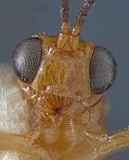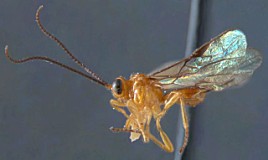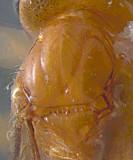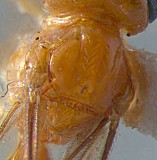Opius Wesmael, 1835
For additional information, see the Opiinae and Braconidae pages.
Two of the remaining species are from the Old World and two are from the Nearctic Region. The Old World species Opius froggatti is known from Australia and New Caledonia and has been reared from at least three species of Bactrocera (Wharton and Gilstrap 1983, Carmichael et al. 2005). Opius mariae is known only from the southeastern corner of Russia, where it has been reared from Myoleja sinensis (Zia) in Lonicera fruit as well as Acidiella echinopanasis Kandybina and possibly Rhagoletis reducta Hering (Tobias 1977).
Opius baldufi and Opius downesi, the two Nearctic species, both have a short hypopygium and share identical features of the clypeus and mandibles with the true members of the genus Biosteres. The general pattern of the fore and hind wing venation is also the same, but the second submarginal cell is slightly longer, and the second metasomal tergum is striate. Based on the number of shared characteristics, it is likely that these two species will eventually be placed in or near Biosteres sensu stricto when this section of the Opiinae is revised. In the restricted sense used here, however, the known hosts of Biosteres belong almost exclusively to leaf-mining Anthomyiidae, and there are as yet no records from Tephritidae. Opius baldufi is a parasitoid of Rhagoletis basiola whereas Opius downesi has been reared from four other species: Rhagoletis berberis, Rhagoletis pomonella, Rhagoletis tabellaria, and Rhagoletis zephyria (Wharton and Marsh 1978, Maier 1981). Opius downesi has a slightly longer ovipositor than Opius baldufi. Opius baldufi has a more restricted distribution in the midwestern US and Utah whereas Opius downesi apparently occurs all across northern US and southern Canada.




